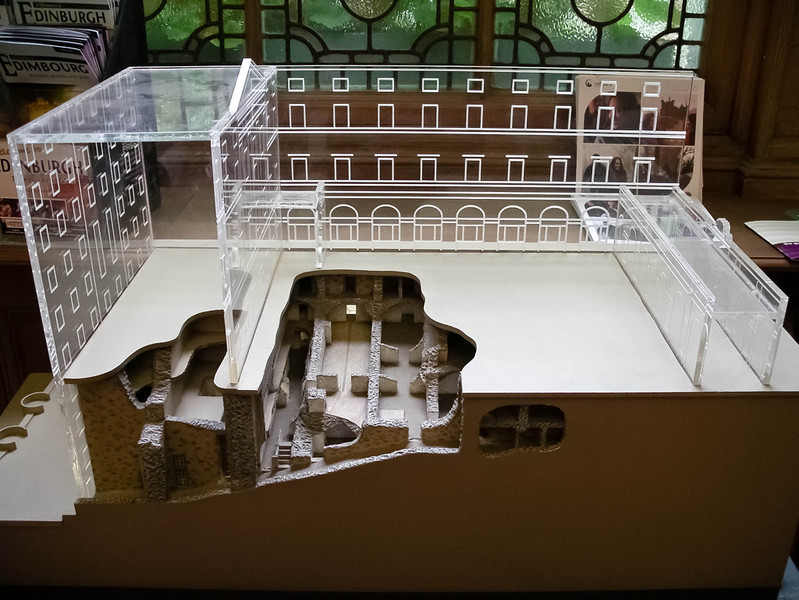Every year millions of people tred upon Edinburgh’s cobblestone Royal Mile. From Edinburgh Castle to Holyrood Palace to St. Giles Cathedral, it is truly a candy store of historical proportions. Shops and pubs line both sides of the Royal Mile today, but it wasn’t always this way. In fact, the Royal Mile used to be just a path on the saddle of a ridge leading to the castle with medieval skyscrapers rising up from the slopes to either side. In the middle of the 18th century, Edinburgh’s architects enacted an ambitious plan to change the fundamental structure and appearance of the Royal Mile – a plan that built houses in the sky and locked away slums beneath their foundations. Edinburgh’s topside historical monuments languish in the elements, but what history molders in the dark beneath the cobbles?
This was the question I sought to answer as I explored Edinburgh’s underground haunts. The city is rife with ghostly tales of apparitions in vaults and the freaky specters of long-dead girls asking for teddy bears. It’s an exciting mythos that draws a lot of interest – just walk down the Royal Mile and count the number of signs advertising ghost tours of Edinburgh’s haunted underground. It’s worth the experience; I’ve been on more than one of Edinburgh’s underground ghost tours myself. This supernatural element is the domain of Edinburgh’s Southbridge Vaults and somewhat disingenuous, however, and it’s why I decided to pay a visit to The Real Mary King’s Close on the Royal Mile, an underground attraction that leans heavily on historical fact.
Little side-streets and alleys called closes intermittently (and haphazardly) punctuate the Royal Mile for the majority of its length. They ooze with character and mystery as some lead into paved stone courtyards or sharply down to lower streets. Mary King’s Close is exactly one of these closes. Except that it’s buried underground. Explaining the engineering feats behind how a street could be paved over is beyond my feeble knowledge of architecture and city planning, suffice to say that in the course of redesigning the Royal Mile certain closes suffered death by entombment. They sheered off the tops of the buildings around Mary King’s Close and constructed foundations level with the Royal Mile. Mind-bending? Yes. Fortuitous? Absolutely. While other closes were paved over in the same manner, they didn’t survive the process. Mary King’s Close is effectively a medieval street in amber.
Mary King’s Close left the consciousness of Edinburgh for nearly two centuries. It was used as an air-raid shelter in the 1940s, but then didn’t see much action until the 1990s when the city council noted waiting lists of people who wanted to explore it. In 2003, The Real Mary King’s Close opened, and its guides have been showing visitors what life was like in the 17th century ever since.
After walking down a dark stairwell, the group I was in came out at the top of the close. An actual street angled steadily down into the dark beyond our vision, but I knew it ultimately led to the old Nor Loch. Doors to buildings opened off to our right and lines hung with clothes, added for effect by the tour company, crossed the street overhead. It was dark and chilly down there, and the air was a stale miasma laden with what I imagined to be latent plague virus. Our guide, Paul, took us through several rooms that used to house families and poured over the details of life in 17th-century Edinburgh. It was a hard life where homes were packed with people, beer was the main beverage since the water was unclean, and plagues ripped through the city. Contrary to popular belief, plague victims were not boarded up in their homes and left to die. The city used a sophisticated system of quarantine, and plague victims put out white flags to indicate they needed food and drink.
Paul mixed wit and humor with the close’s sordid history and even added a scare though this wasn’t a schlocky ghost tour. Eventually we came to the most well-known part of the tour: Little Annie’s shrine. Wee Annie’s ghost is said to haunt the close because she had “the sickness” and was taken from her family before she could even grab a doll. These days her shrine overflows with dolls and figures left by visitors. I was notified by my cynical side that this was, assuredly, BS, but it was a bit of fun nonetheless.
At the bottom of the close, a door opened out on to Market Street, in broad daylight, some 100+ feet below where I entered. Such is the twisty, vertical nature of Edinburgh. The Real Mary King’s Close has recently started offering a “gold experience,” which adds an overground tour of the area. I wish I could have taken photos underground, but photography was prohibited. Guess you’ll just have to see it for yourself. The tour provides an engaging glimpse at historic Edinburgh and dispels many of the myths that have taken root – like, for instance, the rumor that people lived in Mary King’s Close after it was built over. They didn’t.
This is the tour to do if you’re interested in Edinburgh’s underground history. Whatever you do, don’t touch Little Annie’s toys…
Disclosure: I received a complimentary tour from The Real Mary King’s Close. As always, all thoughts and opinions are my own.
Photos by willposh and Shadowgate, respectively, via Flickr/Creative Commons


This underground tour sounds fascinating and something I would love to do! It sure does add a depth to visiting Edinburgh, doesn’t it?
No pun intended, right? 🙂 A historical tour of Edinburgh is a prerequisite for any trip to the city.